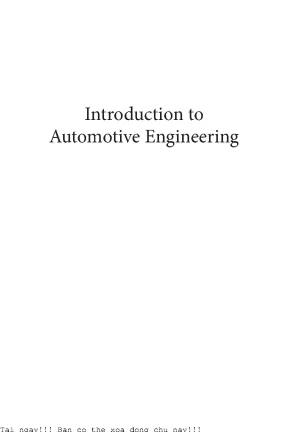Giới Thiệu Về Kỹ Thuật Ô Tô
2019
Phí lưu trữ
30.000 VNĐMục lục chi tiết
Tóm tắt
I. Khám Phá Kỹ Thuật Ô Tô Tổng Quan Về Ngành Công Nghiệp Ô Tô
Ngành công nghiệp ô tô đang phát triển mạnh mẽ với nhiều công nghệ mới. Việc hiểu rõ về công nghệ ô tô là rất quan trọng. Bài viết này sẽ cung cấp cái nhìn tổng quan về các khía cạnh chính của ngành công nghiệp ô tô.
1.1. Ứng Dụng Công Nghệ Trong Ngành Ô Tô
Công nghệ ô tô hiện đại bao gồm nhiều lĩnh vực như hệ thống động cơ, hệ thống phanh, và công nghệ tự lái. Những ứng dụng này không chỉ nâng cao hiệu suất mà còn đảm bảo an toàn cho người sử dụng.
1.2. Tầm Quan Trọng Của Kỹ Thuật Ô Tô Trong Cuộc Sống
Kỹ thuật ô tô đóng vai trò quan trọng trong việc cải thiện an toàn giao thông và giảm thiểu ô nhiễm môi trường. Sự phát triển của công nghệ tự lái hứa hẹn sẽ thay đổi cách thức di chuyển trong tương lai.
II. Những Thách Thức Trong Ngành Kỹ Thuật Ô Tô Hiện Nay
Ngành công nghiệp ô tô đang đối mặt với nhiều thách thức lớn. Từ việc phát triển công nghệ tự lái đến việc giảm thiểu khí thải, các vấn đề này cần được giải quyết một cách hiệu quả.
2.1. Vấn Đề Về An Toàn Giao Thông
An toàn giao thông là một trong những thách thức lớn nhất. Việc cải thiện hệ thống phanh và công nghệ cảnh báo là cần thiết để giảm thiểu tai nạn.
2.2. Giảm Thiểu Khí Thải Và Bảo Vệ Môi Trường
Ngành công nghiệp ô tô cần phải tìm ra các giải pháp để giảm thiểu khí thải. Công nghệ tự lái và công nghệ điện có thể là những giải pháp hiệu quả.
III. Phương Pháp Cải Tiến Kỹ Thuật Ô Tô Giải Pháp Hiện Đại
Để giải quyết các thách thức, ngành công nghiệp ô tô cần áp dụng các phương pháp cải tiến kỹ thuật. Những giải pháp này không chỉ giúp nâng cao hiệu suất mà còn đảm bảo an toàn.
3.1. Cải Tiến Hệ Thống Động Cơ
Cải tiến hệ thống động cơ giúp tăng hiệu suất và giảm tiêu thụ nhiên liệu. Việc áp dụng công nghệ hybrid và công nghệ điện là xu hướng tất yếu.
3.2. Nâng Cao Hệ Thống Phanh
Hệ thống phanh cần được cải tiến để đảm bảo an toàn. Việc áp dụng công nghệ phanh tự động có thể giúp giảm thiểu tai nạn.
IV. Ứng Dụng Thực Tiễn Của Kỹ Thuật Ô Tô Trong Cuộc Sống Hàng Ngày
Kỹ thuật ô tô không chỉ là lý thuyết mà còn có nhiều ứng dụng thực tiễn trong cuộc sống hàng ngày. Từ việc sử dụng ô tô cá nhân đến các phương tiện công cộng.
4.1. Ô Tô Điện Tương Lai Của Ngành Ô Tô
Ô tô điện đang trở thành xu hướng mới. Chúng không chỉ thân thiện với môi trường mà còn tiết kiệm chi phí vận hành.
4.2. Công Nghệ Tự Lái Tiện Ích Và An Toàn
Công nghệ tự lái đang được phát triển mạnh mẽ. Nó hứa hẹn mang lại sự tiện ích và an toàn cho người sử dụng.
V. Kết Luận Tương Lai Của Kỹ Thuật Ô Tô
Tương lai của ngành kỹ thuật ô tô rất hứa hẹn với nhiều công nghệ mới. Việc áp dụng công nghệ tự lái và ô tô điện sẽ định hình lại ngành công nghiệp này.
5.1. Xu Hướng Phát Triển Ngành Ô Tô
Ngành ô tô sẽ tiếp tục phát triển với sự xuất hiện của nhiều công nghệ mới. Công nghệ tự lái và ô tô điện sẽ là những xu hướng chính.
5.2. Tầm Quan Trọng Của Nghiên Cứu Và Phát Triển
Nghiên cứu và phát triển là yếu tố quan trọng để ngành ô tô có thể phát triển bền vững. Các công ty cần đầu tư vào công nghệ mới để đáp ứng nhu cầu thị trường.
TÀI LIỆU LIÊN QUAN

Bạn đang xem trước tài liệu:
Introduction to automotive engineering